Contents
Delphinium elatum
Delphinium elatum is a stately herbaceous perennial prized for its towering spires of vibrant blue flowers. A classic of cottage gardens, it creates a dramatic vertical accent with blooms that rise above many other plants. Each tall spike carries dozens of individual florets, forming a dense column of color that attracts butterflies and hummingbirds. Gardeners value delphiniums for their true-blue shades, a relatively rare color in the flower world. This plant’s striking presence makes it a centerpiece in mixed borders, often paired with other summer favorites like roses, peonies, or airy annuals such as cosmos and zinnias to create a vivid, layered display. While its appearance is delicate and elegant, Delphinium requires attentive care – including rich soil, regular moisture, and staking – to truly thrive and rebloom each year. With proper cultivation, tall larkspur (as it’s commonly known) rewards gardeners with a spectacular early-summer show and an old-fashioned charm reminiscent of storybook cottage landscapes.
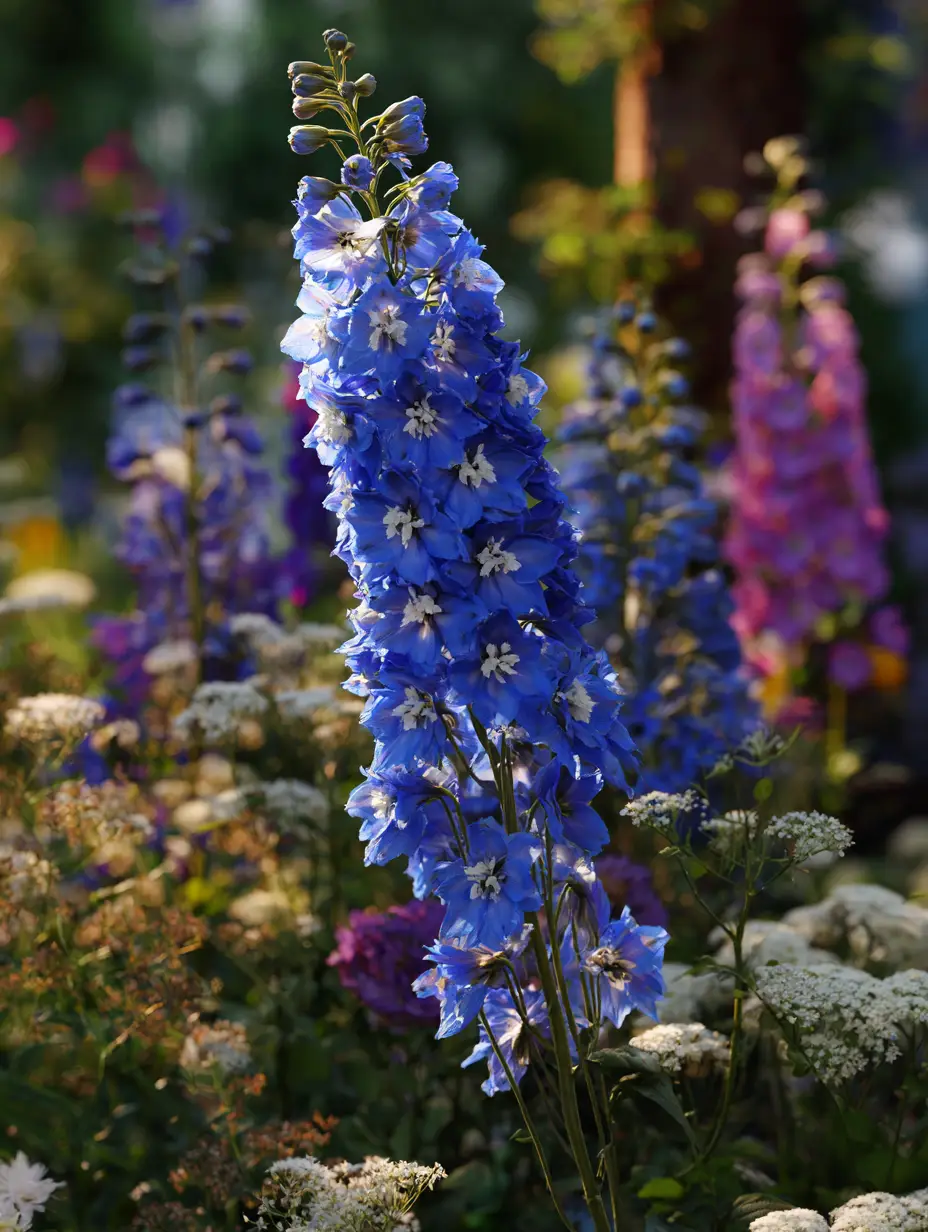
🌱 Taxonomy and origin
Delphinium elatum belongs to the buttercup family, Ranunculaceae, which also includes anemones, ranunculus, and monkshood. In botanical classification, it is in the genus Delphinium, a group of around 300 species known collectively as delphiniums or larkspurs. The species name elatum is Latin for “tall,” an apt description of its lofty flower spikes. This species is often simply called delphinium or larkspur in gardens, though “larkspur” can also refer to its annual cousins now classified in the genus Consolida. Delphinium elatum is native to mountainous and temperate regions of Europe and northern Asia. Wild forms can be found in clearings, woodland edges, and river valleys from central Europe through Siberia. It has a long history of cultivation – records show it was grown in European gardens as early as the 1500s. Over the centuries, horticulturists have developed numerous hybrids from D. elatum, enhancing its flower size, colors, and performance. The genus name Delphinium comes from the Greek word delphis, meaning dolphin, referring to the bottle-nosed shape of the flower buds. This whimsical etymology, along with the plant’s cottage-garden allure, speaks to its blend of natural beauty and cultural significance.
🌸 Bloom time
Delphinium elatum blooms in late spring to early summer, typically peaking in June through July. In most climates, the main flowering occurs once temperatures warm and days lengthen after spring. The show begins with spires packed with buds that open sequentially from the bottom upward, extending the bloom period over several weeks. Each individual floret may be short-lived, but the succession of opening blooms keeps the spike colorful for an extended time. Most commonly, the flowers are an intense sky blue or deep indigo – signature hues for this species – though hybrids can also display white, purple, pink, or bi-color blooms. After the initial flush, gardeners often trim off the spent flower spikes (a practice known as deadheading). With good care, many delphiniums will then produce a secondary, smaller bloom in late summer or early fall. This rebloom is especially likely in cool climates or when plants are well-fed and watered after the first flowering. It’s worth noting that extremely hot weather can shorten the overall bloom duration, as delphinium flowers prefer mild conditions. By providing some afternoon shade in hotter regions and consistent moisture, one can maximize the bloom time. The impressive flowering display of Delphinium elatum makes it a highlight of the early summer garden and a favorite among those who seek continuous color in mixed perennial borders.
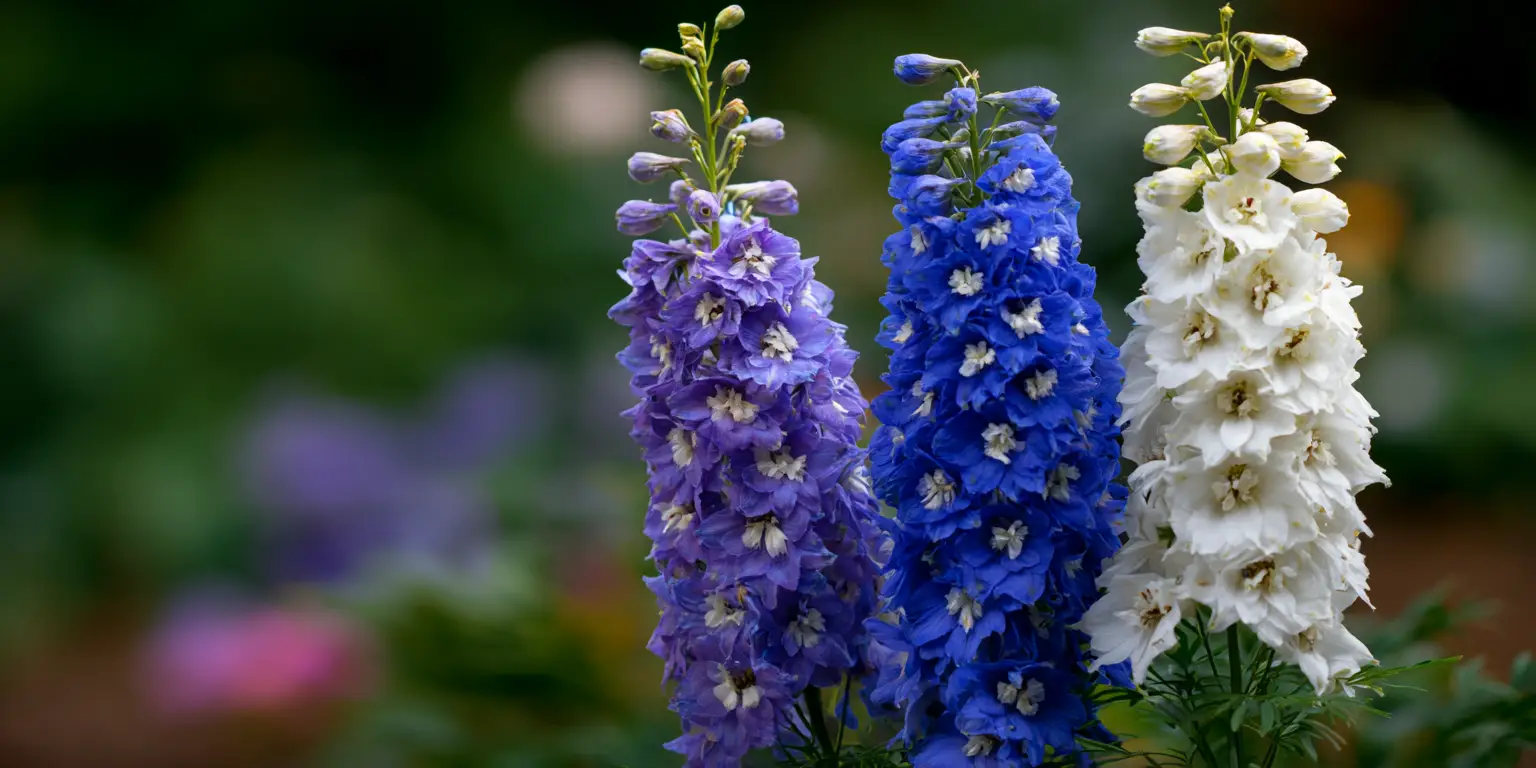
📏 Height and spread
True to its name, Delphinium elatum is a tall, upright perennial. In ideal conditions, the plant reaches about 3 to 6 feet in height (0.9 to 1.8 meters) when in bloom. Some improved hybrid strains can grow even taller – occasionally up to 7 or 8 feet – especially with rich soil and adequate moisture. The height is contributed by the flower spike itself, which rises on a sturdy hollow stem from a clump of foliage at the base. The spread of each mature plant is more modest, typically around 1.5 to 2.5 feet (45 to 75 cm) wide. Delphinium forms a cluster of stems from the crown, with deeply lobed green leaves creating a lush mound roughly a foot or two high when not in bloom. When planting, allow enough space for good air circulation – spacing individual plants about 2 to 3 feet apart helps prevent overcrowding and mildew issues. Because of their impressive height, tall delphiniums are usually positioned toward the back of flower beds or along fences and walls. Gardeners often provide support stakes or grow-through hoops early in the season, since the hollow stems can be fragile. Staking is especially important in windy areas or if the plants aren’t naturally sheltered. Despite their height, the plants don’t aggressively spread or invade, they stay as contained clumps that can gradually enlarge in diameter over a few years. The combination of height and relatively narrow spread makes Delphinium an excellent vertical accent, adding architectural interest without overwhelming neighboring plants.
☀️ Light
Delphiniums thrive with plenty of sunlight but also appreciate some relief from intense heat. Delphinium elatum grows best in full sun, meaning at least 6 hours of direct sunlight per day. In regions with mild or cool summers, full sun exposure all day encourages sturdy stems and abundant flowering. The ample light helps the plant produce strong, upright growth and can reduce issues like powdery mildew (sunlight and good airflow keep foliage drier). However, in areas with hot summers or intense afternoon sun, these plants benefit from partial shade during the hottest part of the day. An ideal situation in warmer climates is morning sun and light afternoon shade, which protects the delphinium from heat stress and scorching. If grown in too much shade, a delphinium will often become leggy, leaning or stretching towards light, and may produce fewer flowers. Too little sun can also weaken the stems, making them more prone to flopping even with staking. When choosing a site, also consider that delphiniums prefer climates with cool nights and moderate summer temperatures. They are famously difficult to grow in very hot, humid regions despite adequate sun, as prolonged heat can cause plants to decline. So, while sunlight is crucial for Delphinium elatum’s success, the quality of that sun (gentle morning rays versus harsh afternoon glare) and the overall temperature play important roles. Providing the right light conditions will ensure robust, floriferous plants with vivid blooms.
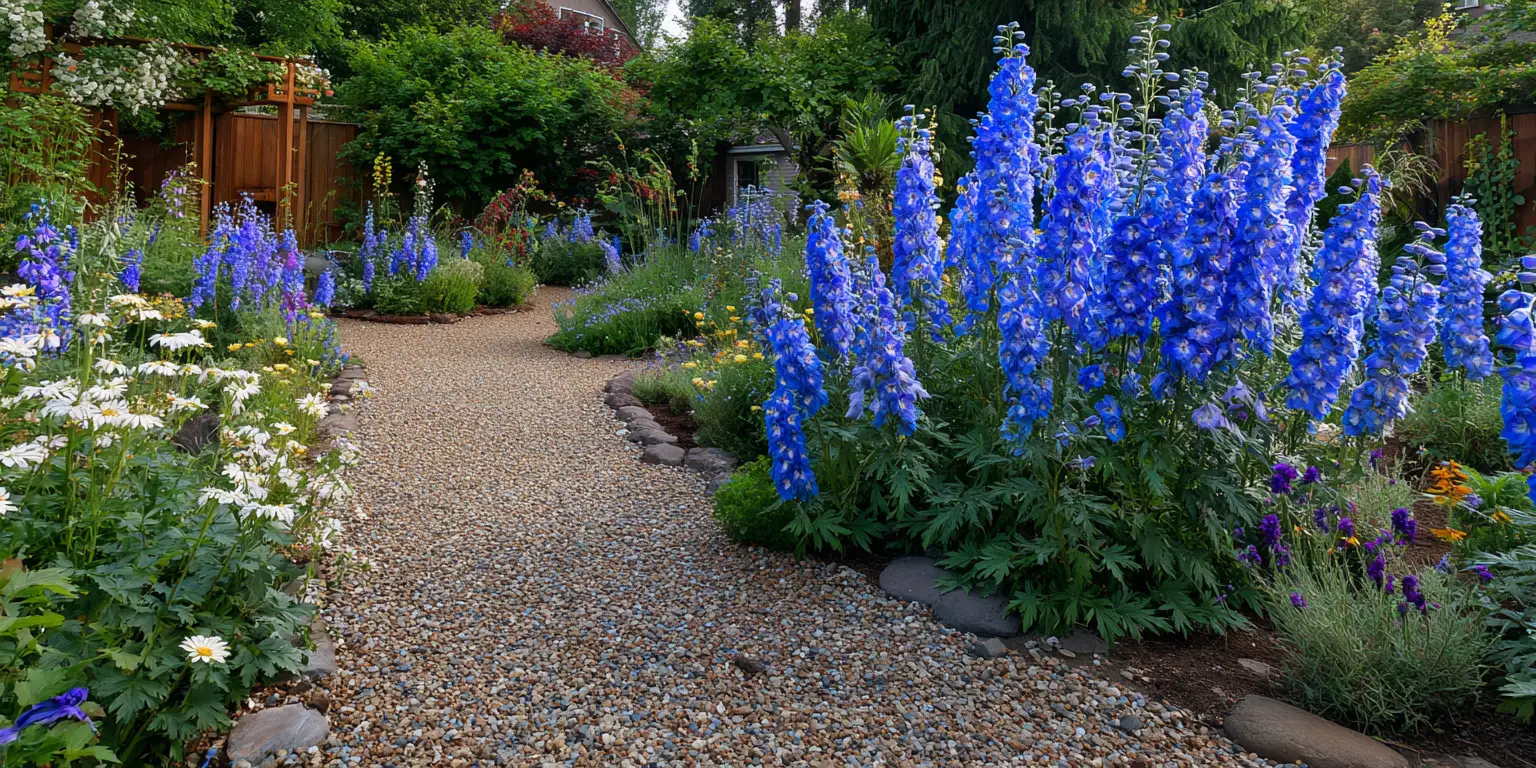
💧 Water
Consistent moisture is key to keeping Delphinium elatum healthy and blooming well. These perennials prefer medium watering, meaning the soil should be kept evenly moist but not waterlogged. In practical terms, that often translates to watering deeply about once or twice a week, depending on rainfall and temperature. The soil should never be bone dry for long periods, as delphinium’s broad leaves and fast growth demand regular water. On the other hand, overly soggy conditions can lead to root and crown rot, so good drainage is as important as adequate water. It’s best to water at the base of the plant rather than overhead, keeping foliage dry helps prevent fungal diseases like mildew and leaf spot. Using soaker hoses or drip irrigation is an effective way to deliver moisture directly to the roots without wetting the leaves. In the heat of summer, especially if planted in full sun, delphiniums may need extra watering to prevent wilting. A layer of mulch around the base of the plant (such as straw, shredded bark, or compost) can help conserve soil moisture and keep the roots cool. Mulching also suppresses weeds that would compete for water and nutrients. Watch young plants and new transplants closely, as their root systems are still developing and may require more frequent watering until established. Conversely, toward the end of the season when the plant has finished blooming and starts to die back, you can reduce watering. Striking the right balance – moist but not wet – will keep delphiniums vigorous and less prone to stress or disease.
🌍 Soil and pH
Rich, well-drained soil is ideal for Delphinium elatum. In its native habitat, it often grows in fertile meadow or woodland soils that are high in organic matter. In the garden, plant delphiniums in a loamy soil that retains moisture but also has good drainage. Incorporating compost or well-rotted manure into the planting area will greatly benefit these heavy feeders, providing nutrients and improving soil structure. Avoid heavy clay that stays waterlogged, as this can cause the roots to rot, especially over winter. If clay soil is the only option, amend it generously with organic matter and perhaps some coarse sand or grit to increase drainage. Regarding pH, delphiniums have a slight preference for neutral to alkaline soil conditions. They perform well in soils with a pH around 7.0 or a bit above. In fact, blue flowers like delphiniums often develop their best color intensity in soils that are not too acidic. Gardeners with very acidic soil (low pH) may consider adding lime to raise the pH closer to neutral if growing delphiniums, though these plants can tolerate mildly acidic soil as long as other conditions are optimal. It’s interesting to note that unlike hydrangeas (which require acidic soil to turn blue), delphiniums inherently bear blue pigments, so soil pH doesn’t change their flower color – but pH can affect nutrient availability and overall plant vigor. Ensuring the soil is slightly alkaline, fertile, and well-aerated will result in stronger stems and more impressive flower spikes. Additionally, good soil health supports the plant’s ability to resist diseases and recover from the energetic output of blooming. Before planting, it’s wise to dig the soil deeply (12-18 inches) and mix in organic matter, creating a hospitable root zone for these tall, hungry perennials.
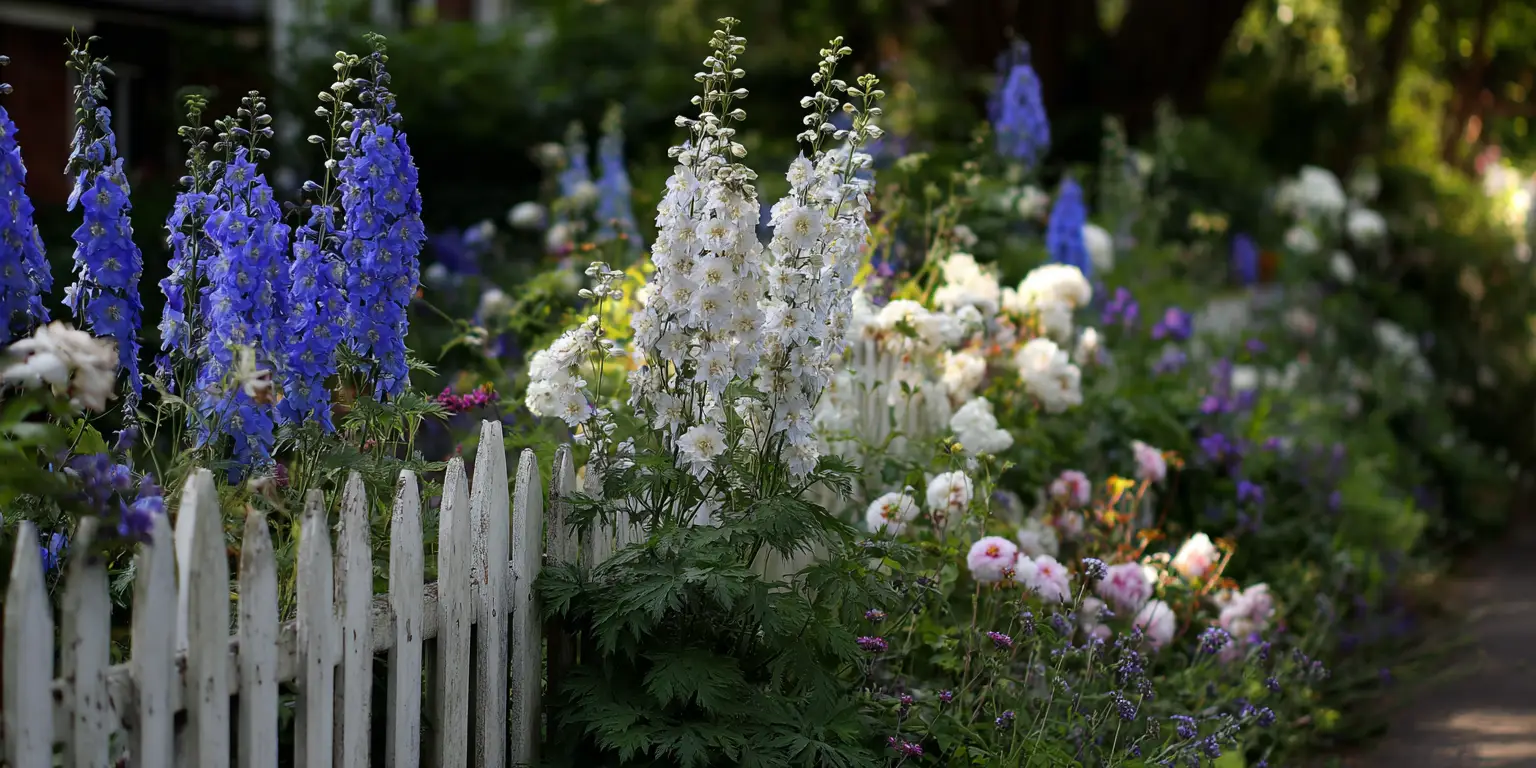
❄️ USDA hardiness
Delphinium elatum is hardy in USDA Zones 3 through 7. This means it can survive winter temperatures down to about -40°F (-40°C) in zone 3, making it suitable for cold, northern climates. In fact, delphiniums generally prefer cooler regions, they originated in parts of Europe and Asia with cold winters and moderate summers. In zones 3-7, the plants behave as perennials, dying back to the ground in winter and resprouting from the roots in spring. They require a period of winter dormancy and cool temperatures to thrive year after year. In Zone 8, success with delphiniums can be hit or miss – much depends on summer heat and humidity. In areas of Zone 8 with cool summers (for example, coastal regions or high elevations), delphiniums may act as short-lived perennials. However, in hot-summer Zone 8 locations and in Zones 9-10, Delphinium elatum struggles. Prolonged high heat can cause dormancy or death, the plant often cannot get through a scorching summer, even if winters are mild. Gardeners in warmer zones sometimes treat delphiniums as annuals or biennials: they might plant them in fall or late winter to grow and bloom in spring, then accept that the plants will likely not survive the peak of summer. Another strategy in marginal climates is to plant delphiniums in a spot with morning sun and afternoon shade, as well as provide excellent soil moisture and mulching to keep roots cool. Still, generally these dramatic perennials are best suited to regions with cool or moderate summers. If you’re unsure about their performance in your zone, local gardening groups or extension services can provide insight. As a rule of thumb, consider Zone 7 the southernmost reliable range for perennial delphiniums, and always check if newer hybrid varieties tout improved heat tolerance if you’re attempting them in warmer areas.
🌼 Propagation and longevity
Delphinium elatum can be propagated through seeds, cuttings, or division, though each method has its nuances. Growing from seed is common for delphiniums, especially for producing many plants at once. Seeds can be started indoors 8-10 weeks before the last frost, or sown outdoors in late fall to undergo natural cold stratification over winter. Fresh delphinium seeds tend to have better germination rates, as viability can decrease over time. Some gardeners even chill seeds in the refrigerator for a couple of weeks before sowing to simulate winter conditions, since cold exposure can improve germination. Patience is required: seeds may take 3-4 weeks to sprout, and typically plants grown from seed will not bloom until their second year. It’s worth noting that seeds from hybrid cultivars may not come true to the parent plant’s qualities (color, height), so serious growers propagate prized cultivars vegetatively.
Cuttings are a reliable way to clone a particular delphinium cultivar. The usual approach is to take basal cuttings in spring. As new shoots emerge from the crown, you can remove a shoot that’s 3-4 inches long, ideally with a bit of root or heel attached. These cuttings are then rooted in a free-draining medium (like a sand and peat mix) in high humidity until they establish roots. Using rooting hormone on the cut end can improve success. Basal cuttings allow you to propagate plants that are identical to the parent, preserving traits of named varieties. This method is moderately challenging but useful for gardeners wanting more of a specific hybrid.
Division is another propagation method, though it can be tricky for delphiniums due to their deep taproot and somewhat brittle, fleshy root system. Generally, division is done on mature plants in early spring, just as new growth starts, or in fall after flowering (in climates where fall transplanting is feasible). A large, healthy clump can be carefully dug up and split into a few sections, making sure each section has buds and roots attached. Transplant the divisions promptly and keep them well-watered until re-established. Not all delphiniums respond well to being divided – some gardeners report success, while others find the plants sulk or don’t survive. If a clump is old and starting to decline in vigor, division can rejuvenate it, but if a plant is doing well, it’s often best to leave it undisturbed aside from taking the occasional cutting.
In terms of longevity, Delphinium elatum is generally considered a relatively short-lived perennial. Many cultivars will live around 3 to 5 years, and sometimes only 2 or 3 years under less-than-ideal conditions. This is a similar lifespan to other exuberant perennials like lupines and gaillardias. Several factors contribute to this: the plant’s heavy blooming can be exhausting, and they are susceptible to root and crown issues over time. To keep delphiniums going in your garden, it’s wise to have a renewal plan. You might let some flowers go to seed and encourage new self-sown seedlings to take the place of aging plants (though be cautious, as seedlings of hybrids may vary). Alternatively, start new seeds every couple of years, or keep a few cuttings growing on. Gardeners in climates where delphiniums thrive often maintain a cycle of propagation so that there are always young plants coming on as older ones die out. With attentive care – proper fertilization, pest management, and perhaps dividing or propagating – it is possible to extend an individual plant’s life somewhat. But it’s best to think of delphiniums as perennials that may need to be periodically renewed to keep that splendid display going for many years continuously.
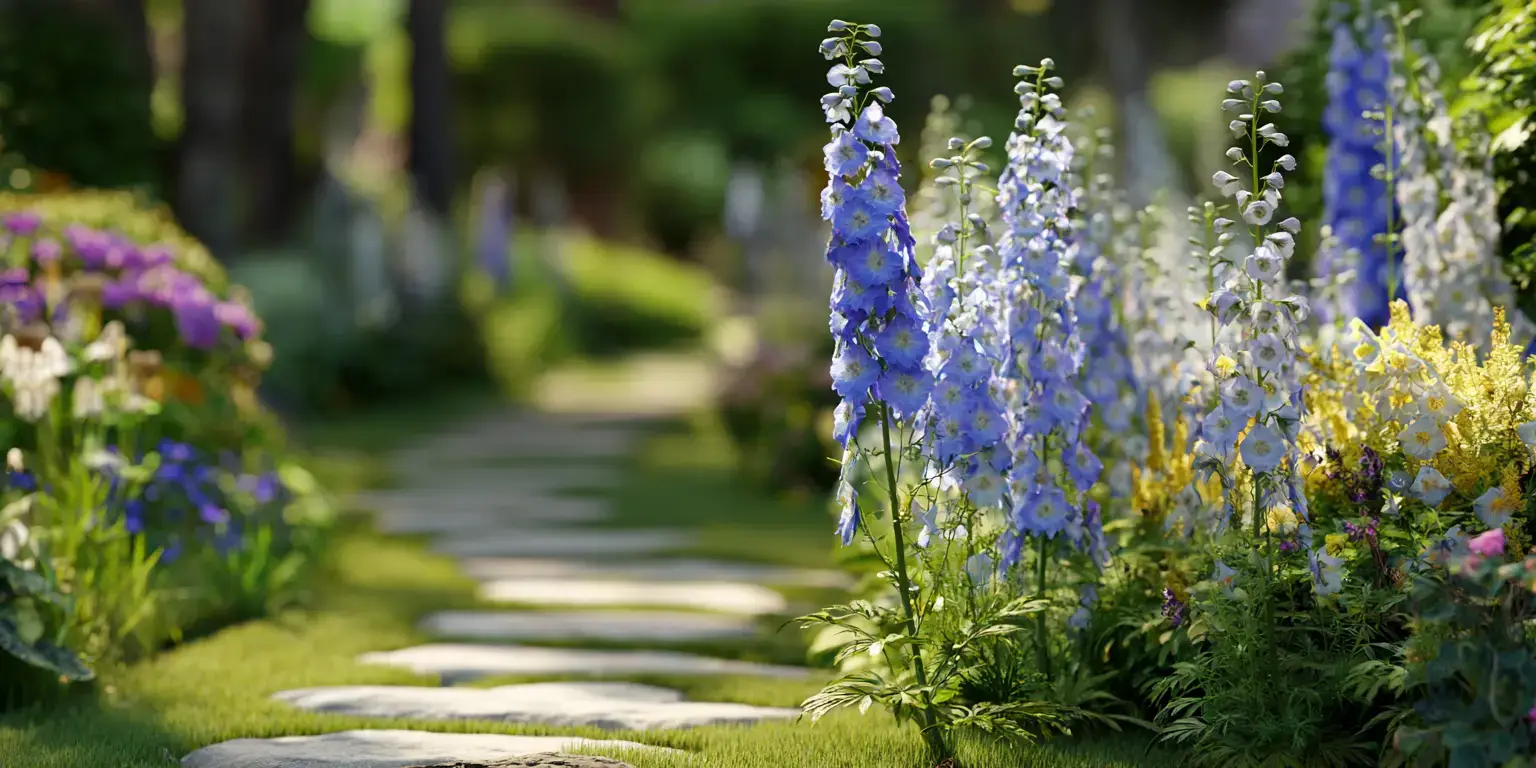
👃 Fragrance
Despite their stunning visual appeal, delphinium flowers are not particularly known for fragrance. Delphinium elatum blooms generally have little to no scent detectable to humans. The plant’s strategy in nature relies more on bright colors and nectar to attract pollinators (like bees and butterflies) rather than perfuming the air. When you stand next to a blooming delphinium spike, you might notice a faint earthy or mildly sweet aroma if you have a keen sense of smell, but it’s nothing like the strong floral perfumes of lilacs or lavender. Gardeners do not grow delphiniums for their smell – in fact, many describe the flowers as essentially fragrance-free.
It’s worth mentioning, however, that a few modern hybrid cultivars have been noted to carry a light fragrance. Plant breeders have occasionally selected for scent along with color and form. For example, certain varieties like ‘Violets Are Blue’ are advertised as having a mild sweet fragrance when in bloom. These are the exception rather than the rule. Even when present, the scent of a delphinium is subtle and won’t typically carry on the breeze or fill a garden the way a rose or jasmine can.
In cut flower arrangements, delphiniums add striking height and color, but they won’t contribute much aroma to a bouquet. This makes them useful for people who are sensitive to strong floral fragrances but still want dramatic flowers on display. If fragrance in the garden is a goal, one would need to pair delphiniums with other blooming plants that are known for scent. For instance, planting them near peonies or nicotiana can add perfume to the area where the delphiniums provide visual impact. In summary, expect delphinium’s beauty to be primarily visual, any fragrance is a bonus but not a prominent feature of this plant.
⚠️ Toxicity and pet safety
All parts of Delphinium elatum are considered toxic to humans and animals if ingested. Like many members of the buttercup family, delphiniums contain potent alkaloids (such as delphinine and others) that can cause serious poisoning. In fact, larkspurs and delphiniums are well-documented for poisoning livestock in the wild – cattle or horses that graze on young larkspur plants can be paralyzed or even killed by the toxins. In a garden setting, the risk is primarily to curious children or pets who might chew on the plant. Eating any part of a delphinium (leaves, flowers, seeds, or roots) can lead to symptoms such as burning of the mouth, nausea, vomiting, abdominal pain, and diarrhea. In severe cases, it may cause muscle weakness, confusion, lowered heart rate, and respiratory difficulty, potentially resulting in death if enough is consumed. The highest concentration of toxins is often in the seeds and new growth.
Because of this, pet safety and child safety measures should be taken. If you have cats, dogs, or young children who play in the yard, consider planting delphiniums in a spot that is less accessible or behind a barrier. Fortunately, the plant’s taste is reportedly very bitter and unpalatable, so most animals and people are not tempted to consume it. Cases of pet poisoning are relatively rare compared to some other ornamental plants (for instance, azaleas or lilies which also pose dangers). However, caution is still warranted. Wear gloves when pruning or handling delphiniums if you have sensitive skin, as some people experience mild dermatitis from the sap (though this is not as common as with related plants like monkshood). Always wash hands after handling the plant, especially before eating or touching your face.
It’s also wise to keep delphinium clippings out of reach – for example, don’t leave spent cuttings in a pile where pets might nibble them. When disposing of or composting the plant material, do so securely. If someone or some pet does ingest a part of the plant, seek medical or veterinary attention promptly and have a sample of the plant for identification. In summary, delphiniums are beautiful but poisonous ornamentals, so they should be planted and handled with respect. By being aware of their toxicity and taking simple precautions, you can enjoy their beauty in the garden without incident.
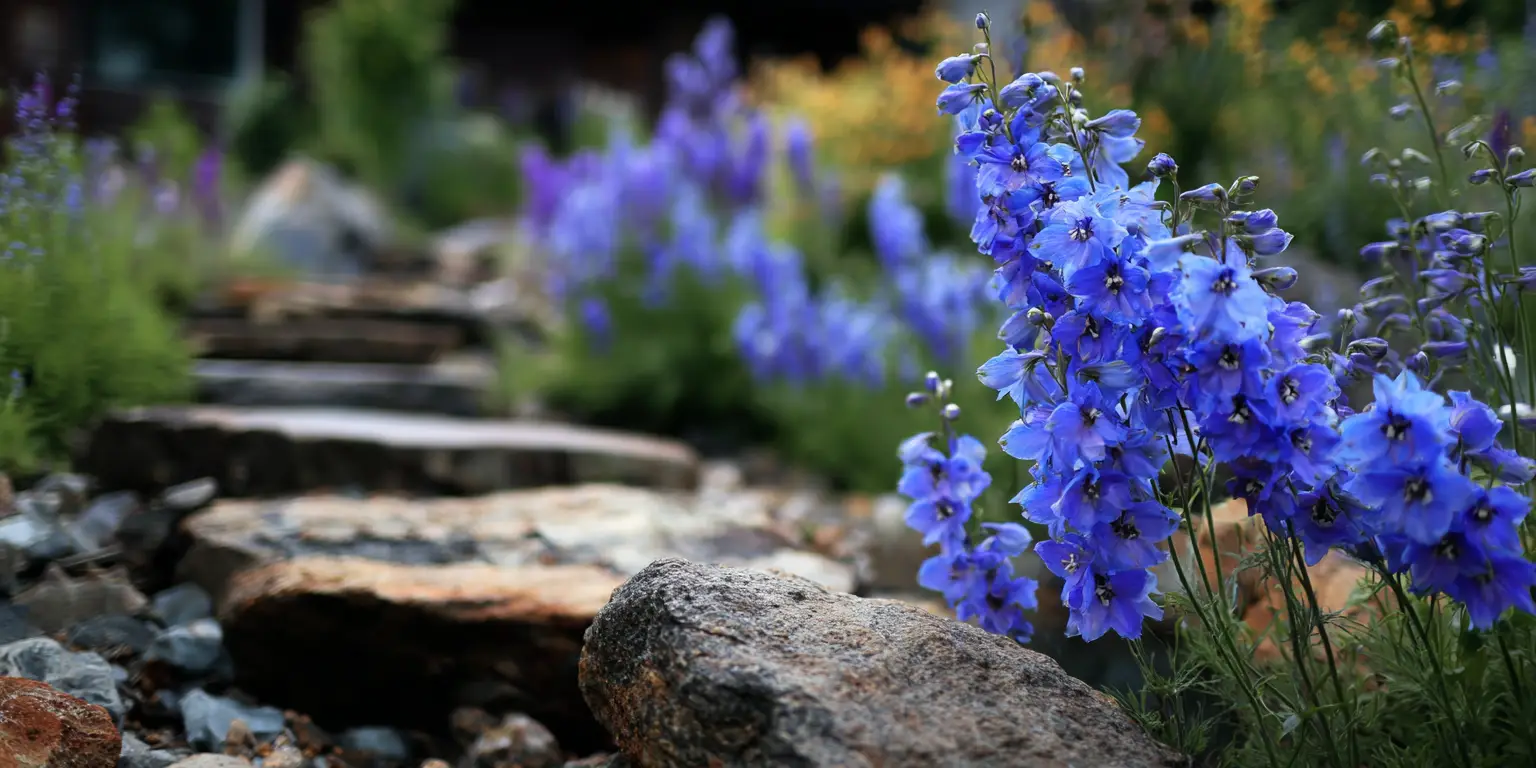
🌿 Vase life
With their dramatic spikes and rich colors, delphiniums make excellent cut flowers for arrangements – provided they are harvested and handled properly. Delphinium elatum generally has a vase life of about 5 to 7 days under good conditions, though some stems can last up to 8-10 days. To maximize the longevity of delphiniums in a vase, it’s important to cut them at the right stage and give them appropriate care. The best time to cut a delphinium stem is when about 1/4 to 1/3 of the flowers on the spike have opened (usually the lowest blossoms), while the rest are still in bud. This ensures you have some open color but also plenty of buds that will continue to open gradually in the vase, extending the display.
When cutting, use a sharp, clean knife or pruners and immediately place the stems in water. Remove any leaves that would sit below the water line in your vase to reduce bacterial growth. It’s recommended to re-cut the stem ends at an angle under water or in a bowl of water when you bring them inside – this prevents air bubbles from entering the stem and helps with water uptake. Using a floral preservative in the vase water can significantly improve vase life, the preservative provides nutrients and keeps the water clean. Delphiniums are known to be sensitive to ethylene, a natural gas released by aging fruit and decaying plant material that can age flowers faster. Therefore, keep arrangements away from ripening fruit and from wilting flowers of other types. Also, display delphinium arrangements in a cool location, out of direct sunlight and away from heat sources or drafts, to avoid premature wilting.
A unique aspect of delphinium cut flowers is that their stems are geotropic – they will bend upwards toward the sky if the stems are stored or laid horizontally. Florists know to store delphinium stems upright to keep them straight. If you receive or purchase delphiniums that have a curve from being in a box, you can try to straighten them by rehydrating them in a tall upright container. As the water moves up the stem, they often firm up and stand straighter. While in the vase, the upper buds will continue to open over several days. You may gently remove spent blossoms from the bottom of the spike as they wither to keep the arrangement looking fresh. With these care tips, you’ll be able to enjoy the elegant beauty of delphinium blooms in your home for nearly a week. Remember to always use clean vases and fresh water – a well-tended delphinium stem is surprisingly long-lasting for such a delicate-looking flower.
🐛 Pests and diseases
Growing Delphinium elatum can come with a few challenges, as these plants are somewhat high-maintenance and susceptible to certain pests and diseases. One of the most notorious pests for delphiniums are slugs and snails. These slimy garden critters love to chew on the tender young shoots and leaves, often causing significant damage in spring just as the plants are getting started. Gardeners should be vigilant early in the season, using slug bait, traps, or barriers (like copper tape or crushed eggshell mulches) to protect emerging delphinium shoots. Hand-picking slugs on damp evenings or mornings can also help keep their population down. Another common pest is the aphid – those tiny green or black sap-sucking insects may cluster on stems and buds, causing distortion of flowers and growth. If aphids appear, a strong jet of water can knock them off, or one might use insecticidal soap or neem oil for heavier infestations. Japanese beetles and caterpillars occasionally feed on delphinium foliage and petals as well, depending on your region. Additionally, an insect known as the delphinium borer (the larva of a moth) can tunnel into stems, causing wilting. If you notice any stems that suddenly droop and die, inspect for holes and consider removing and destroying those stems to stop the borer’s life cycle.
Diseases are another concern. Powdery mildew is a frequent issue on delphiniums, especially in humid or damp, shaded conditions. This fungal disease appears as a white, dusty coating on leaves and stems, and can weaken the plant if severe. To mitigate mildew, ensure good air circulation around plants (proper spacing), avoid overhead watering, and plant in full sun if possible. Fungicidal sprays (like sulfur or neem-based products) can help protect foliage if applied at the first signs of mildew. Another disease, botrytis blight (gray mold), can affect flowers and leaves in wet weather, causing a fuzzy gray mold and rot on petals and stems. Removing spent blooms and any diseased plant debris promptly will reduce botrytis spores. Leaf spot diseases may also occur, leading to brown or black spotting on foliage, again, keeping water off the leaves and cleaning up in fall helps prevent these issues.
Delphiniums can suffer from crown rot and root rot if in poorly drained soil. This often shows up as the plant collapsing or dying from the base, sometimes accompanied by a bad smell in the soil. Avoid planting too deep – the crown (where stem meets root) should be at or just above soil level – and make sure the soil drains well to prevent rot. If a plant does get crown rot, it’s usually best to remove and discard it, and improve the soil conditions before replanting in that spot.
On the positive side, deer and rabbits typically leave delphiniums alone due to their toxicity and bitter taste. This makes delphinium a deer-resistant choice for gardens that otherwise suffer from grazing wildlife. Also, if plants are kept healthy and strong with proper care, they are better at resisting and recovering from pest and disease attacks. Regular feeding with a balanced fertilizer and fall cleanup (cutting down and disposing of the old stems after frost) can break pest and disease cycles. In summary, while delphiniums do demand some extra attention to pests and diseases, many gardeners find the effort worthwhile. By being proactive – protecting against slugs, monitoring for aphids, providing good airflow, and avoiding excess moisture on foliage – you can significantly reduce problems and enjoy lush, tall plants with minimal damage.
FAQs
How do I plant and care for Delphinium elatum to get the best blooms?
Plant Delphinium elatum in fertile, well-draining soil in a spot with full sun (or morning sun and afternoon shade if your summers are hot). When planting, mix in compost to give it nutrient-rich conditions. Space plants about 2-3 feet apart to ensure good air circulation. Water regularly to keep the soil evenly moist – don’t let it dry out completely – but also avoid waterlogging the roots. It helps to stake the plants when they are 1-2 feet tall, using a bamboo cane or stake and soft ties to support the hollow stems. As the plant grows, tie incrementally higher. Feed the plants with a balanced flower fertilizer in spring as growth begins, and again in mid-summer after the first bloom. Also, remove spent flower spikes promptly (deadheading) to encourage a possible second flush of blooms. In the fall, after frost kills back the top growth, you can cut the stems down to basal leaves or to the ground. Mulch over winter to protect the roots, especially in colder zones. With this care regimen, you’ll have healthier plants that produce the best possible blooms each season.
Do delphiniums come back every year?
Yes, delphiniums are perennials in suitable climates, meaning the same plant can come back each year. In zones 3-7, Delphinium elatum will go dormant in winter and resprout from the root crown in spring. However, they are often considered short-lived perennials. This means an individual plant might only live for a few years (commonly around 3-5 years, sometimes less) even with good care. Many gardeners treat them almost like a long-term biennial, expecting to replant or propagate new ones after several years. If your delphiniums don’t return after a particularly harsh winter or they dwindle after a couple of summers, it may not be your fault – it’s partly the nature of the plant. Ensuring good drainage over winter (so the crown doesn’t rot) and avoiding excessive summer stress can help them live longer. To have delphiniums in the garden continuously, it’s wise to start some new plants from seed or cuttings every couple of years to replace any that die out.
Are Delphinium elatum and annual larkspur the same thing?
They are related but not the same. Delphinium elatum is a perennial species (part of the genus Delphinium proper), whereas the plants commonly called annual larkspur were traditionally classified as Consolida. The most common annual larkspur is Consolida ajacis, which many seed catalogs still label as “larkspur.” Recently, botanists have been revising classifications, and you might see Consolida species sometimes folded back into the Delphinium genus, which adds to the confusion. The key differences: perennial delphiniums (like D. elatum) are generally taller, have thicker, separated petals (sepals) and come primarily in blues, purples, and whites. Annual larkspur has a wider color range including pinks, reds, and even yellow, and its flowers are usually more delicate on thinner spikes. Annual larkspur is grown from seed each year and prefers cooler spring weather to sprout and bloom before heat hits. Delphinium elatum is a hardy plant that survives winters and comes back from its roots. Gardeners often use annual larkspur to fill in beds and provide color in the first year while perennial delphiniums are still getting established. Both are beautiful blue flowers and share that dolphin-shaped bud and spur (hence both are called larkspur), but they differ in lifecycle and some botanical details. If you’re looking for the tall, year-after-year spikes, make sure to get perennial delphinium plants, if you want a quick, easily seeded flower for one season, annual larkspur is the one.
What causes my delphinium stems to flop or break, and how can I prevent it?
Delphinium stems are hollow and can be brittle, so there are a few common causes for flopping or breaking. Wind and heavy rain can easily knock over tall flower spikes, especially when they are in full bloom (the blossoms make the spike top-heavy). Lack of support is one issue – typically, gardeners should stake delphiniums or use rings/cages to support them as they grow. Another cause can be insufficient light, plants grown in partial shade might stretch taller and develop weaker, thinner stems that can’t hold up well. Additionally, if the soil is too rich in nitrogen or if they are over-fertilized with a high-nitrogen feed, delphiniums might grow very lush and tall quickly but with weaker tissue, predisposing them to flopping. To prevent problems, stake plants early and securely. Use multiple stakes around a large clump or a grid support for a row of delphiniums. Place them in a spot sheltered from the strongest winds (for example, near a fence or hedge, or among other sturdy plants). Also ensure they get enough sun to develop stout stems. Watering at the base keeps foliage dry and less heavy. After flowering, when you cut the spikes for deadheading, you remove that weight and the plant typically won’t flop for the rest of the season. Some newer cultivars are being bred for stronger, thicker stems to reduce the need for staking, but in general with traditional varieties, some support is almost always necessary. If a stem does break prematurely, you can sometimes salvage it as a cut flower indoors.
Can I grow Delphinium elatum in containers?
It is possible to grow delphiniums in large containers, though it can be challenging due to their size and need for consistent care. If you want to try, choose a sizable pot – at least 18-20 inches in diameter and depth for a single Delphinium elatum plant, because they have a substantial root system and need room to grow tall. Ensure the pot has good drainage (multiple holes) because waterlogged soil will quickly harm the plant. Use a high-quality potting mix enriched with compost, and consider adding some grit or perlite for extra drainage. Place the container in a spot with plenty of sun but where you can also easily water it, pots dry out faster than ground soil, so you’ll need to be attentive to watering, possibly daily in hot weather. Stake the delphinium in the pot just as you would in the ground – insert a stake when planting, so you can tie the stem as it grows. One advantage of containers is you can relocate them if needed (for example, to give afternoon shade in hot climates or to protect from a storm). Feeding is important too: use a balanced, water-soluble fertilizer every 2-3 weeks during the growing season since nutrients leach out of pots more quickly with regular watering. Dwarf varieties like the Magic Fountains series are better suited to containers than the tallest types, due to their shorter height and slightly more compact habit. Even with the best care, a delphinium in a pot might not live as long as one in the ground – the root confinement and potential for stress are higher. Nonetheless, if ground space is limited, container cultivation can reward you with those gorgeous blooms on a patio or balcony. Treat the plant as you would in the ground in terms of overwintering: it will die back in winter, and the pot may need insulation (wrapping or moving to a sheltered spot) in very cold areas to protect the roots from freezing.
What is the July birth flower and is it related to delphinium?
Yes, one of the traditional July birth flowers is the larkspur, which includes Delphinium. In many birth flower lists, “larkspur” represents the month of July (often alongside water lily as an alternate). Larkspur is essentially an old-fashioned common name that can refer to delphiniums. The choice likely comes from the abundance of larkspurs blooming in mid-summer (July in the Northern Hemisphere) and their popularity in cottage gardens. Symbolically, larkspur is said to signify qualities such as dignity, positivity, and an open heart. Because Delphinium elatum is a type of larkspur, it indeed is part of that July birth flower designation. If you were born in July, a bouquet or planting of blue delphiniums is especially meaningful. Just remember, if giving a delphinium as a gift for a July birthday, to also give care instructions due to its special requirements (and mention it’s toxic so they keep it away from pets or children). It’s a beautiful way to celebrate a birth month with a flower that has both historical significance and ornamental charm.
Interesting tips
- Delphinium elatum got its name from Greek delphis (dolphin) because the flower buds were thought to resemble little dolphins diving through the air. Once you know this, the dolphin shape is fun to spot in the buds!
- Historically, blue delphinium flowers were used to create dyes and inks. Early American settlers and Native Americans would boil the blossoms to produce a blue dye for clothing or ink for writing.
- Despite their delicate look, delphiniums are considered deer-resistant and rabbit-resistant. The same toxins that make them poisonous protect them from being a salad buffet for grazing wildlife, which is a bonus for gardeners in rural areas.
- The species name elatum means “tall,” but some modern hybrids can grow even taller than their wild ancestors – exceptional garden delphiniums have been known to reach over 8 feet with ideal conditions and staking.
- In the Victorian language of flowers, larkspur (delphinium) symbolized an open heart and ardent attachment. It’s also commonly cited as the July birth flower, making it a popular choice for summer birthday bouquets and symbolic gardens.